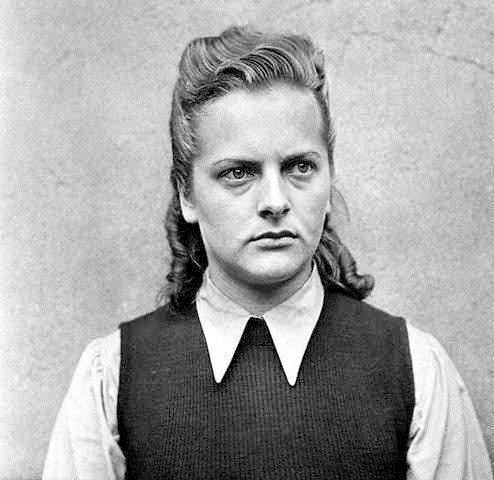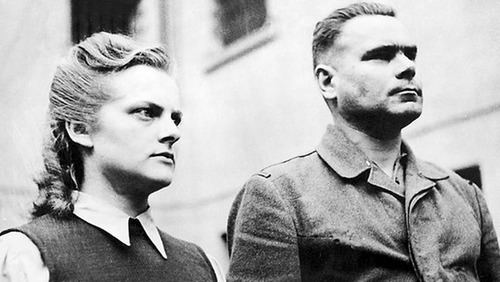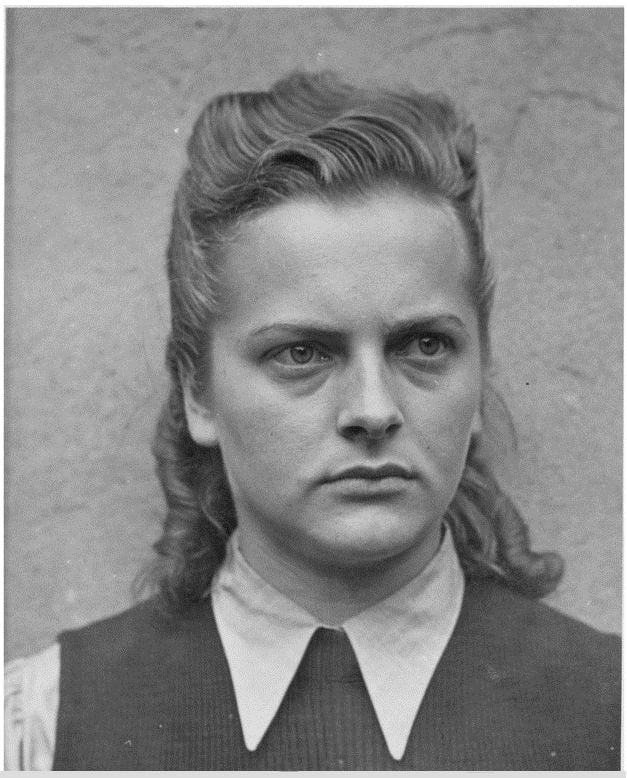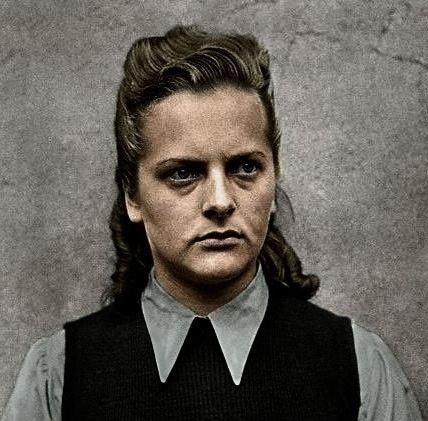Years of service 1942–1945 | Rank SS-Helferin Name Irma Grese | |
 | ||
Similar People | ||
Parents Alfred Grese, Berta Grese | ||
Irma grese photostory 1
Irma Ida Ilse Grese (7 October 1923 – 13 December 1945) was a female SS guard at the Nazi concentration camps of Ravensbrück and Auschwitz, and served as warden of the women's section of Bergen-Belsen.
Contents
- Irma grese photostory 1
- Monster s among human s part 2 irma grese
- Early life and family
- Concentration camp guard
- War crimes trial
- Execution
- Dramatizations
- References

Grese was convicted for crimes against humanity committed at Auschwitz and Bergen-Belsen, and sentenced to death at the Belsen trial. Executed at 22 years of age, Grese was the youngest woman to die judicially under British law in the 20th century. Auschwitz inmates nicknamed her the "Hyena of Auschwitz" (German: die Hyäne von Auschwitz).

Monster s among human s part 2 irma grese
Early life and family

Irma Grese was born to Berta Grese and Alfred Grese, a dairy worker, on 7 October 1923. Irma was the third of five children (three girls and two boys). In 1936, her mother committed suicide by drinking hydrochloric acid after discovering that Alfred had had an affair with a local pub owner's daughter. Historian Peter Vronsky speculated that Alfred Grese joined the Nazi Party in 1937, and remarried in 1939.

Irma's sister, Helene Grese, noted at Irma’s trial that in primary school, when “girls were quarreling and fighting, [Irma] never had the courage to fight, but… ran away." Irma left school in 1938 at age 14, probably due to a combination of a poor scholastic aptitude, bullying by classmates, and a fanatical preoccupation with the League of German Girls (Bund Deutscher Mädel), the Nazi female youth organization, of which her father disapproved. Among other casual jobs, she worked as an assistant nurse in the sanatorium of the SS for two years and unsuccessfully tried to find an apprenticeship as a nurse.
Concentration camp guard
By the time she was a teen, Irma devoted herself to the Nazi cause and trained to become a nurse, but after a series of failures, she became obsessed with the Hitler Youth and the Band of German Maidens. By the time she was eighteen, she had moved to the SS Female Helpers’ training base, which was located near Ravensbrück, the all-female concentration camp. After her training, which stressed “the feminine ideal of nurturance,” she volunteered to work at Ravensbrück, where she exceeded her supervisors’ expectations because of her brutality and wholehearted devotion to the cause. She was everything the Nazi party wanted a guard to be—blindly dedicated— and was soon promoted to a guard position at Auschwitz-Birkenau. From mid-1942 she was an Aufseherin (guard) at Ravensbrück, and in March 1943 she transferred to Auschwitz-Birkenau. In the second half of 1944 she was promoted to Rapportführerin, the second-highest rank open to female KZ-wardens. In this function she participated in prisoner selections for the gas chambers.
Quickly after gaining power, Grese gained a reputation as an amoral sadist. She was considered to be a nymphomaniac who slept with SS guards as well as prisoners—the latter, forcibly. She bribed young Jewish girls to stand watch for her as she raped other inmates, and, according to inmate and doctor Giselle Perl, Grese “relished whipping well-developed young women on the breasts… Grese would eventually become sexually aroused just watching the women suffering." Her violence was psychological, sexual, and almost inhuman. She beat prisoners until their faces were completely raw, kicked them with her hobnailed jackboots until blood flowed, used her dog on the prisoners, forced men and women to hold rocks above their heads and kneel for hours at a time, and had a “whip which [she] used consistently whenever necessary." In early 1945, Grese accompanied a prisoner evacuation transport from Auschwitz to Ravensbrück. In March 1945, she went to Bergen-Belsen along with a large number of prisoners from Ravensbrück. Grese was captured by the British on 17 April 1945, together with other SS personnel who did not flee.
Grese inspired virulent hatred in prisoner Olga Lengyel, who wrote in her memoir Five Chimneys that selections in the women’s camp were made by SS Aufseherin Elisabeth Hasse and Irma Grese. The latter was visibly pleased by the terror her presence inspired in the women at roll call. Grese had a penchant for selecting not only the sick and the weak but any woman who had retained vestiges of her former beauty. Lengyel said that Grese had several lovers among the SS in the camp, including Josef Mengele. After Grese forced the inmate surgeon at the infirmary into performing her illegal abortion, she disclosed that she planned a career in film acting after the war. Lengyel felt that Grese’s meticulous grooming, custom-fitted clothes and overuse of perfume were part of a deliberate act of sadism directed toward the ragged women prisoners.
War crimes trial
Grese was among the 45 people accused of war crimes at the Belsen Trial. She was tried over the first period of the trials (17 September – 17 November 1945) and was represented by Major L. Cranfield. The trials were conducted under British military law in Lüneburg, based on charges derived from the Geneva Convention of 1929 regarding the treatment of prisoners. The accusations against her centered on her ill-treatment and murder of those imprisoned at the camps. Survivors provided detailed testimony of murders, tortures and other cruelties, especially towards women, in which Grese engaged during her years at Auschwitz and Bergen-Belsen. They testified to acts of sadism, beatings and arbitrary shootings of prisoners, savaging of prisoners by her trained and allegedly half-starved dogs, and her selecting prisoners for the gas chambers. Grese was reported to have habitually worn heavy boots and carried a whip and a pistol. Witnesses testified that she took pleasure in using physical and psychological methods to torture camp inmates and enjoyed shooting prisoners in cold blood. They also claimed that she beat some women to death and flogged others using a plaited whip.
Under direct examination, Irma Grese testified about her background,
I was born on 7 October 1923. In 1938 I left the elementary school and worked for six months on agricultural jobs at a farm, after which I worked in a shop in Lychen for six months. When I was 15 I went to a hospital in Hohenlychen, where I stayed for two years. I tried to become a nurse but the Labor Exchange would not allow that and sent me to work in a dairy in Fürstenberg. In July 1942, I tried again to become a nurse, but the Labour Exchange sent me to Ravensbrück Concentration Camp, although I protested against it. I stayed there until March 1943, when I went to Birkenau Camp in Auschwitz. I remained in Auschwitz until January 1945.
During the trial the press labelled Grese as "the Beautiful Beast" alongside Kommandant Josef Kramer ("the Beast of Belsen"). Although the charges against some of the other female wardens (a total of 16 were charged) were as serious as those against Grese, she was one of only three female guards to be sentenced to death. After a 53-day trial, Grese was sentenced to death by hanging.
To have a woman not only partake in but take pleasure in the crimes committed was considered an anomaly, and captured the world’s interest. Society viewed women at the time as “typically less violent”, and if they committed crime at all, it was of a “domestic nature." However, the crimes that Grese committed were far from “less violent” and “domestic.” She committed them on her own volition and against SS orders, which proved that she did not just blindly follow command; it is safe to say that most (if not all) of the acts of violence she committed were entirely her own decision.
Execution
Grese and two other concentration camp workers, Johanna Bormann and Elisabeth Volkenrath, were convicted along with eight men for crimes committed at Auschwitz and Belsen and sentenced to death. As the verdicts were read, Grese was the only prisoner to remain defiant. Her subsequent appeal was rejected.
The night before her execution, Grese sang Nazi hymns until the early hours of the morning with Johanna Bormann. On Thursday, 13 December 1945, in Hamelin Jail, Grese was led to the gallows. The women were executed singly by long-drop hanging and then the men in pairs. Regimental Sgt. Maj. O'Neill assisted the British executioner, Albert Pierrepoint:
We climbed the stairs to the cells where the condemned were waiting. A German officer at the door leading to the corridor flung open the door and we filed past the row of faces and into the execution chamber. The officers stood at attention. Brigadier Paton-Walsh stood with his wristwatch raised. He gave me the signal, and a sigh of released breath was audible in the chamber, I walked into the corridor. 'Irma Grese', I called.
Dramatizations
Angel: A Nightmare in Two Acts is a drama by Jo Davidsmeyer based on the life and execution of Irma Grese and Holocaust survivor Olga Lengyel.
Irma Grese has been portrayed as a minor character in two films: Pierrepoint, which portrays her execution following the Belsen war crimes trial; and Out of the Ashes. Both films feature additional female guards in much smaller roles. Grese is also briefly portrayed in a non-speaking re-enactment in Auschwitz: The Nazis and the 'Final Solution'.
She was also one of the inspirations for the Nazi exploitation film, Ilsa, She Wolf of the SS.
Grese also figured as a character in the Martin Amis novel The Zone of Interest, in which someone says she is known as the Beautiful Beast.
